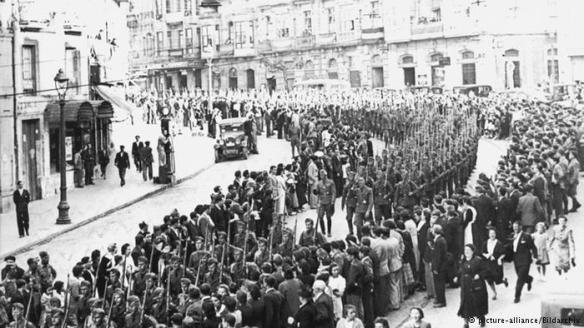
The Condor Legion takes part in a victory parade in Madrid on May 19, 1939
There were other reasons why, from the Condor Legion’s point of view, large-scale operativ warfare was just not in the cards. The main fighter was the He-51, a biplane with a fixed landing gear that was completely outclassed by the Soviet-supplied I-16 Rata. Practically the only role for which the He-51 could still be used was close support. This was all the more important because the Nationalists were short of artillery and were forced to rely on air power to make up the shortage. Acting in small groups of twos and threes and rarely more than 10 or 12, legion bombers, operating with fighter support, blasted a way for the infantry through the mountain passes that led first to the northwest country and later eastward to the Mediterranean. Light bombers and ground-attack aircraft also took an active part in the set piece battles that developed at Jarama, Guadalajara, Brunete, Teruel, and later along the Ebro. In all these cases, close support meant just what its name implied, often to the point that aircraft, acting as flying artillery, were interchangeable with the legion’s 88-millimeter antitank guns used in the ground role. Thanks to the aircraft’s low speed and the altitudes at which they made their attacks on occasion, as little as 50 to 200 meters-they were often able to pound enemy forces within 50 meters of friendly ones. When this naturally led to attacks on friendly forces, the Nationalists began wearing white signs on their backs. Even so, such attacks were by no means rare.
Thus, the Germans in Spain both violated their own doctrine-which explicitly rejected the use of air power within the range of ground artillery-and found their hopes for operativ warfare frustrated to a large extent. However, this is not to say that they did not learn many important lessons. This was the first time since 1918 that Luftwaffe personnel had seen any action at all. Commanders, pilots, and ground crews gained experience that they, acting as instructors, were later able to pass to others. Every kind of mission was flown, including air-to-air combat for which Capt Werner Moelders developed his “four-finger” formation, which was later to be famous. The nature of the ground organization needed to support air warfare was studied in depth; in 1937-38, the legion, alternating between the northwest and the country around Madrid, was already able to display the astonishing capability for the rapid redeployment of its forces that was to serve the Luftwaffe well later on. It was in Spain that Richthofen, who began by serving as the legion’s chief of staff and then took over as its commander in chief, served his apprenticeship. It was to turn him into perhaps the world’s leading exponent of close air support, an expertise demonstrated to the full in 1941 and 1942, when he was called upon to provide air support to Hitler’s Balkan campaign and to the conquest of Sevastopol. The experience gained was invaluable.
When the legion finally returned home in May 1939, the Luftwaffe found itself in a strange situation. Both its own doctrine and that of the ground forces-as embodied in the famous Truppenfuehrung (Forces Guidance) of 1936 continued to stress operativ warfare as the only one in harmony with Clausewitzian ideas and, moreover, with Germany’s own peculiar strategic situation. However, that kind of warfare had hardly been practiced in Spain; as some Luftwaffe officers saw the problem, conditions in that country had more to do with war in China or Ethiopia than among major European powers. The kind of mission with which the Luftwaffe had had the most experience and which had proved most successful was close support; however, the dive-bombing aircraft considered most suitable for this mission only made up some 16 percent of its combat strength. To make matters worse, ground-to-air and air-to-ground communications had barely advanced beyond the point where they had been at the end of World War I. No progress whatsoever had been made in the coordination of air power with armored forces, given that tanks in Spain were only present in small numbers and, in view of the nature of the terrain and of the struggle itself, tended to be used overwhelmingly in the infantry-support role . Richthofen himself, while on maneuvers, noted that the army’s generals, specifically Heinz Guderian, failed to understand either the capabilities or limitations of air power. Throughout World War II, this highly intelligent air officer was to regard the army as “unteachable.”